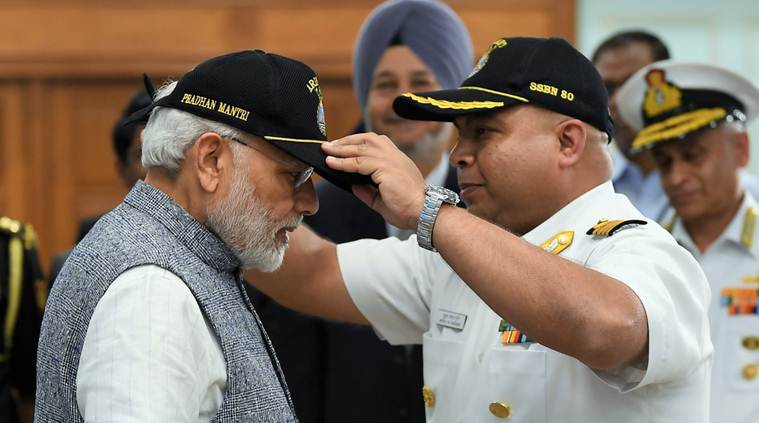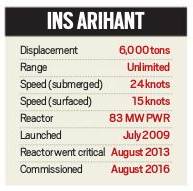INS Arihant’s patrol over: Nuclear-triad in place, submarine our shield against blackmail, says PM Modi
INS Arihant, a strategic asset, was developed for over two decades under the Advanced Technology Vessel (ATV) programme, which comes directly under the Nuclear Command Authority headed by the Prime Minister.

PM Modi meets the crew of INS Arihant. (Source: PMO / Twitter)
India announced Monday the completion of its survivable nuclear triad by adding maritime strike capability to land and air-based delivery platforms for nuclear weapons. Prime Minister Narendra Modi, while declaring that India’s first nuclear ballistic missile submarine had completed its maiden “deterrence” patrol, said INS Arihant was an “open warning” (khuli chetavni) to “enemies of India and peace” and a “fitting response to nuclear blackmail”.
Receiving the crew of INS Arihant, the Prime Minister said: “I congratulate all those involved, especially the crew of INS Arihant for this accomplishment, which will always be remembered in our history.”
India has become the sixth country — after US, Russia, UK, France and China — to have a fully operational nuclear triad.
“In an era such as this, a credible nuclear deterrence is the need of the hour. The success of INS Arihant gives a fitting response to those who indulge in nuclear blackmail,” Modi said.
He was referring to the ‘second-strike’ capability provided by an SSBN (Ship Submersible Ballistic Nuclear) which is not only nuclear-powered but armed with nuclear missiles as well. It means that India can hide its ballistic missiles at sea for a long period of time and hit back at the enemy from sea, if its land and air-based delivery systems have been neutralised by the enemy in a nuclear strike.
Modi underlined that “as a responsible nation, India has put in place a robust nuclear command and control structure, effective safety assurance architecture and strict political control, under its Nuclear Command Authority. It remains committed to the doctrine of Credible Minimum Deterrence and No First Use, as enshrined in the decision taken by the Cabinet Committee on Security in its meeting chaired by the then Prime Minister Shri Atal Bihari Vajpayee on January 4, 2003.”
During a deterrence patrol, a nuclear submarine carries nuclear missiles on board, where the command and control protocols for its operations are fully tested by the crew. As the term signifies, a deterrence patrol is meant to deter an adversary from launching a first nuclear-strike since the SSBN can launch a retaliatory strike within minutes.
INS Arihant, a strategic asset, was developed for over two decades under the Advanced Technology Vessel (ATV) programme, which comes directly under the Nuclear Command Authority headed by the Prime Minister.
INS Arihant is India’s first indigenously-designed, developed and manufactured nuclear-powered ballistic missile submarine, and three more such submarines are reportedly under various stages of construction.
Designed in the 1990s, the INS Arihant development project was officially acknowledged in 1998 and the submarine was launched in 2009. The nuclear reactor of the submarine went critical in 2013 and it was commissioned three years later.






































No hay comentarios:
Publicar un comentario